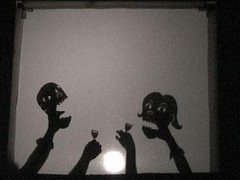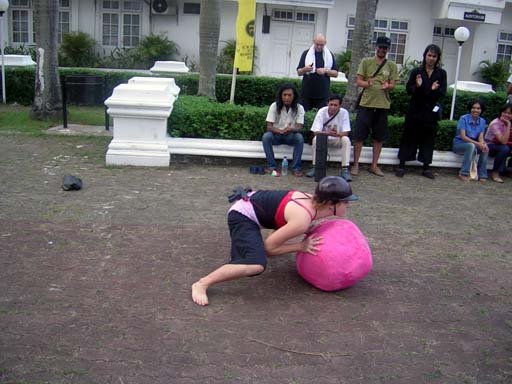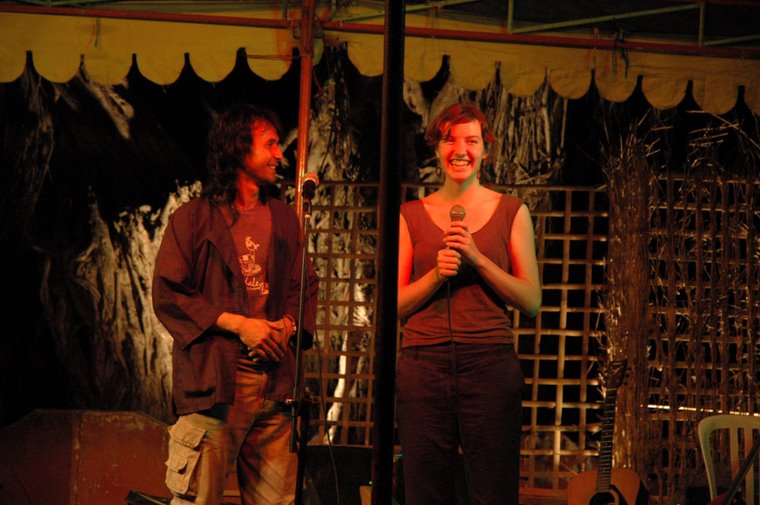
In Taiwan about an hour southwest of Taipei is the small city of Shijr. Surrounded by mountains and lakes, Shijr is a typical Taiwanese city, packed with high-rise apartment buildings, shops, temples and open-air markets. The streets are busy and full of activity, but a ten-minute walk will bring you to a quiet lake where fishermen relax and wait for fish to come, groups of Taiwanese do early-morning tai-chi, and families stroll on the cobblestone paths with their neatly groomed dogs.
Not ten minutes back into the city from one particular lake, called Jen-Lei Lake, you will find the Dream Community. The Dream Community is an art and living community started by a man named Gordon Tsai. The story goes that over fifty years ago before Taiwan began developing into what it is today, the site where the Dream Community now stands were rice fields owned by Gordon’s family. Once Taiwan began developing, Gordon and his family were forced to join with the changes in order to survive, building several high-rise apartments on their rice fields. Despite this new development, Gordon still had a strong desire to create something more than just high-rise apartments. He wanted to continue the sense of community and bring something new to the stale idea of progressiveness that he was witnessing all around him. Thus, he established the Dream Community.
Today, the Dream Community is a compound of roughly seven high-rise apartment buildings with one new building in the making, a bakery, theater and two cafes, two dance studios, a music studio, a sewing room and artist residence apartments currently being built. The focus of the Dream Community is to bring art to the local community, with a focus on celebrational performing arts, and puppetry.
 Once a year, the Dream Community puts on an annual Dream Parade. The idea of the parade takes influence from the infamous ‘Carnival’ of Brazil, and several other celebrational art parades including the Fremont Solstice Parade in Seattle, USA, and the May Day Parade in Minneapolis, USA. Up to thirty artists from all over the world are invited to come and take part in the parade, teaching workshops to the local community and collaborating with Taiwanese artists. This year, September-November 2006, included artists from Thailand, Mexico, India, America, France, Brazil, and Indonesia. The theme of te parade was ‘Aboriginal Culture’, blended with elements of the ‘Animal Kingdom’. Aboriginal Taiwanese artists were invited to collaborate with the Brazilian samba team, and international artists were asked to bring their own traditional culture to share. Me and my partner, Lilik, along with our friend Ivan, a musician originally from Mexico who has lived in Bali for several years, came to teach and represent the culture of Indonesia.
Once a year, the Dream Community puts on an annual Dream Parade. The idea of the parade takes influence from the infamous ‘Carnival’ of Brazil, and several other celebrational art parades including the Fremont Solstice Parade in Seattle, USA, and the May Day Parade in Minneapolis, USA. Up to thirty artists from all over the world are invited to come and take part in the parade, teaching workshops to the local community and collaborating with Taiwanese artists. This year, September-November 2006, included artists from Thailand, Mexico, India, America, France, Brazil, and Indonesia. The theme of te parade was ‘Aboriginal Culture’, blended with elements of the ‘Animal Kingdom’. Aboriginal Taiwanese artists were invited to collaborate with the Brazilian samba team, and international artists were asked to bring their own traditional culture to share. Me and my partner, Lilik, along with our friend Ivan, a musician originally from Mexico who has lived in Bali for several years, came to teach and represent the culture of Indonesia.As the Indonesia team, we had many different traditional cultures from within Indonesia to choose from. Given that we would be teaching these new skills to local Taiwanese families and children, who had no former experience or real understanding of the art of Indonesia, we decided to keep it simple and not too complicated. In the end, we divided our team into several groups, which later in the parade would become one whole; The Ondel-ondels, the Jatilans, the Baris Dancers, the Fruit Ladies, and the gamelan musicians. In a tented workshop space, we worked with other artists from morning until night every day, helping people who came to create the costumes they needed, working on ondel-ondel and doing workshops in traditional dance and gamelan. On days off or during breaks, we would go to the park and play, to night markets and try strange new foods, and ride the underground subway to Taipei to visit friends and be tourists in the big city.
 By the day of the parade, the workshop space was overflowing with newly made art pieces, the majority of them made with building techniques from bamboo, paper maiche, and costume-making. Hours before the parade was to begin, hundreds of participants gathered at the starting point at a community college in the nearby city of NeiHu. There were giant tree floats, unicycle teams, stilt-walkers, people riding bicycles made into fish and bugs, bellydancers, aboriginal samba-players, samba dancers, one team of a hundred lions, a blues band playing on a mushroom float, a crocodile, a large group of young butterflies, a dancing baby in a monkey costume, our Indonesia team, and much more. Each group was given a specific location in the parade, and everyone lined up when it was time to begin the procession. Our Indonesia team gathered in the soccer field, an array of colors and shimmering gold, traditional costume and
By the day of the parade, the workshop space was overflowing with newly made art pieces, the majority of them made with building techniques from bamboo, paper maiche, and costume-making. Hours before the parade was to begin, hundreds of participants gathered at the starting point at a community college in the nearby city of NeiHu. There were giant tree floats, unicycle teams, stilt-walkers, people riding bicycles made into fish and bugs, bellydancers, aboriginal samba-players, samba dancers, one team of a hundred lions, a blues band playing on a mushroom float, a crocodile, a large group of young butterflies, a dancing baby in a monkey costume, our Indonesia team, and much more. Each group was given a specific location in the parade, and everyone lined up when it was time to begin the procession. Our Indonesia team gathered in the soccer field, an array of colors and shimmering gold, traditional costume and  ringing bells and gongs. Me and Lilik both carried ondel-ondel, with two more being carried by Taiwanese men. Ivan joined with the gamelan group, wearing traditional Balinese ceremonial dress. The length of the parade route was only 3 km, but enough to be quite tired by the end. A pulsing of sound and rhythm served as the backbeat to the entire event, and hundreds of onlookers came to join in the fun. Smiles shone on everyone’s faces, laughter continued to ring out and the event proved to be an enjoyable experience for all.
ringing bells and gongs. Me and Lilik both carried ondel-ondel, with two more being carried by Taiwanese men. Ivan joined with the gamelan group, wearing traditional Balinese ceremonial dress. The length of the parade route was only 3 km, but enough to be quite tired by the end. A pulsing of sound and rhythm served as the backbeat to the entire event, and hundreds of onlookers came to join in the fun. Smiles shone on everyone’s faces, laughter continued to ring out and the event proved to be an enjoyable experience for all.It was sad in the end to say goodbye to all the great people we had the opportunity to work with in Taiwan. So many of our students were so caring and giving, always bringing us little gifts and snacks of traditional Taiwanese mooncakes and green tea. The young children who would run around and play or help us to work on paper maicheing and various other tasks. The day of the parade was great fun, but for me, even more satisfying was the opportunity to get to know the local community of Taiwan, to understand something more about their culture and ways of living, to make new friends, and work on creating something together. I will never forget such a unique experience, and wouldn’t be surprised if I try and return to take part in the parade again next year.































No comments:
Post a Comment